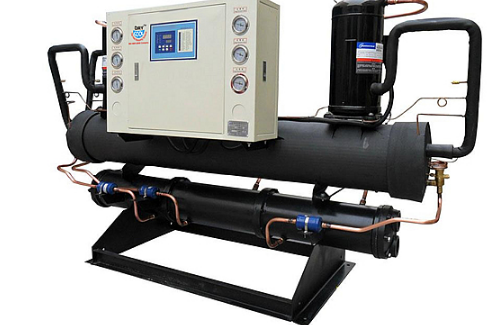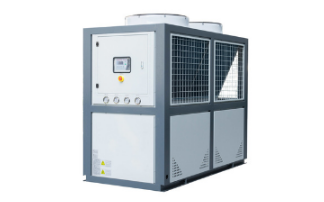Using a chiller in injection molding maintains consistent cooling, preventing defects, optimizing cycle times, and enhancing part quality.
The Role of Chillers in Injection Molding
Basic Function of Chillers in the Molding Process
Chillers are essential in injection molding for temperature control. They perform two key functions:

Heat Removal: Chillers extract excess heat from the mold. This ensures proper plastic solidification.
Temperature Regulation: They maintain a consistent mold temperature. This is vital for uniform part quality.
Efficiency Boost: A chiller can cut cooling times by 30-50%. This depends on part specifications and mold design.
Types of Chillers Used in Injection Molding
There are mainly two types of chillers in injection molding:
Air-Cooled Chillers: These use ambient air for cooling. They are easier to set up and need less upkeep. However, their efficiency drops in hot conditions.
Water-Cooled Chillers: These use water for heat removal. They are more efficient than air-cooled types, especially for large-scale operations.
Power and Cost:
Air-Cooled Chillers: Their power use ranges from 2 to 6 kW/ton. This can lead to higher operational costs in warm areas.
Water-Cooled Chillers: They consume about 0.9 to 1.1 kW/ton. While energy-efficient, they require more initial investment and a steady water supply.
Selecting a Chiller: The choice depends on the factory environment, space, and cooling needs. The right chiller enhances molding efficiency and product quality.
For additional insights on chillers in injection molding, the Injection Molding Chillers Wikipedia page offers valuable information.
Benefits of Using Chillers in Injection Molding
Enhancing Cooling Efficiency
Chillers significantly improve cooling efficiency in the injection molding process. Their impact includes:
Reduced Cycle Time: By efficiently cooling the mold, chillers can shorten the cycle time. On average, chillers can reduce cooling time by 20-40%.
Energy Savings: Efficient cooling translates to less energy consumption. Chillers can reduce overall energy use by up to 15% in the molding process.
Increased Production: With shorter cycle times, more parts can be produced in the same timeframe, boosting productivity.
Cost-Benefit Analysis: While chillers add to upfront costs, they save money in the long run through energy efficiency and increased output.
Improving Product Quality and Consistency
Chillers play a vital role in enhancing the quality and consistency of injection molded products:
Uniform Cooling: Chillers provide consistent mold temperatures. This uniformity is critical for achieving consistent part quality.
Reduced Defects: Proper cooling reduces defects like warping and shrinkage. Consistent quality control can lead to a reduction in scrap rates by up to 20%.
Material Handling: Some materials are sensitive to temperature variations. Chillers help maintain the ideal conditions for these materials, ensuring optimal quality.
Quality vs. Cost: Investing in effective chilling solutions enhances product quality, which can lead to higher customer satisfaction and lower material waste.
For more detailed information on the advantages of using chillers in injection molding, including their impact on efficiency and product quality, the Injection Molding Chillers Wikipedia page is a comprehensive resource.
Impact of Chillers on Cycle Time
Reducing Cooling Time in the Injection Molding Cycle
Using chillers effectively can substantially reduce the cooling time in injection molding. The table below illustrates this impact:
| Cooling Aspect | Without Chiller | With Chiller | Impact on Cycle Time |
|---|---|---|---|
| Average Cooling Time | 40-60 seconds | 20-30 seconds | Reduces by 30-50% |
| Mold Temperature Consistency | Fluctuates | Stable | Improves cycle consistency |
| Energy Consumption for Cooling | Higher due to inefficiency | Lower due to efficient cooling | Reduces energy costs |
Note: The reduction in cooling time directly translates to shorter overall cycle times, enhancing productivity.
Analyzing the Relationship Between Chiller Efficiency and Overall Cycle Time
The efficiency of chillers is closely linked to the overall cycle time in injection molding. The following table breaks down this relationship:
| Chiller Efficiency Factor | Impact on Injection Molding | Quantitative Effect |
|---|---|---|
| Cooling Rate | Faster cooling rates lead to quicker solidification | Cycle time can decrease by 10-20% |
| Temperature Control Accuracy | Precise temperature control reduces defects and rework | Increases overall efficiency by 5-10% |
| Power Consumption | Efficient chillers use less power, reducing operational costs | Energy cost savings of up to 15% |
Overall Impact: High-efficiency chillers not only reduce the cooling time but also contribute to energy savings and improved molding quality, thus enhancing the overall efficiency of the injection molding process.
For more comprehensive insights into the impact of chillers on the injection molding process, including their influence on cycle time and efficiency, the Injection Molding Chillers Wikipedia page offers valuable information.





